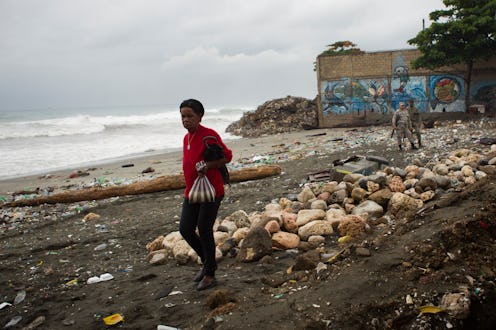News
This Is How Fiercely Hurricane Irma Could Hit The Dominican Republic

The strongest storm on record in the Atlantic Ocean is now moving westward towards the east coast. Hurricane Irma's wind speeds have reached 185 mph, the strongest ever recorded for an Atlantic storm. And as Floridians prepare for what could potentially be a devastating landfall, residents of several Caribbean islands are also bracing for its impact. And that includes the Dominican Republic, where a hurricane warning ahead of Irma was issued on Wednesday.
According the the National Hurricane Center, Irma is expected to hit the Dominican Republic's northern coastline on Thursday. That area is designated in the "Major Hurricane" zone, which means that if Irma stays on course, the Dominican Republic will be hit with some of its most powerful winds. And if the hurricane comes through during high tide, the National Hurricane Center says the effects could be "potentially catastrophic."
CNN meteorologist Chad Myers also warned about being in the hurricane's eye wall — the area right outside the center eye of the hurricane, where the fastest winds and dangerous thunderstorms occur. According to Myers, "that devastates the island, no matter what island it is." As of now, the Dominican Republic is at risk for just such an impact, as Irma moves northwest.
While most Americans are probably watching to see how Irma impacts the continental United States, this hurricane is already one for the history books. Besides its winds being the strongest on record for any storm in the Atlantic Ocean, Irma has now also made itself known on another measurement — the seismometer. Used for tracking the scale of earthquakes, the size of Irma is such that seismometers are picking it up.
Importantly, this doesn't mean Irma is causing earthquakes; it isn't. What it does mean is that Irma's wind power is so strong that the way it is rattling trees is shaking their roots to the point of causing the ground itself to tremble. Additionally, storm surge waves could also be causing seismometers to pick up and "track" Irma, as the force from their size and momentum crashes onto shorelines.
As Hurrican Irma travels over the Caribbean, meteorologists warn that some islands could see storm surges of up to 20 feet. For island dwellers, that could be devastating. High tides combined with a hurricane the size and strength of Irma make for extremely dangerous conditions.
But for now, the Dominican Republic is under a hurricane warning, and sits in the projected path of Irma's trajectory.